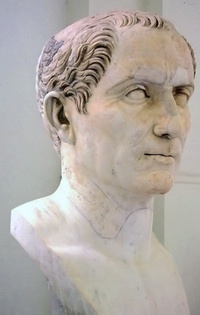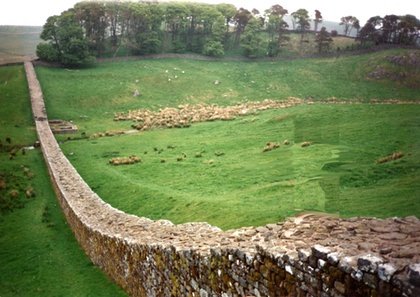Roman Britain
Siân Echard, University of British Columbia

 In his Gallic Wars, Julius Caesar describes Britain [5:12-14]:
In his Gallic Wars, Julius Caesar describes Britain [5:12-14]:
The interior portion of Britain is inhabited by those of whom they say that it is handed down by tradition that they were born in the island itself: the maritime portion by those who had passed over from the country of the Belgae for the purpose of plunder and making war; almost all of whom are called by the names of those states from which being sprung they went thither, and having waged war, continued there and began to cultivate the lands. The number of the people is countless, and their buildings exceedingly numerous, for the most part very like those of the Gauls: the number of cattle is great. They use either brass or iron rings, determined at a certain weight, as their money. Tin is produced in the midland regions; in the maritime, iron; but the quantity of it is small: they employ brass, which is imported. There, as in Gaul, is timber of every description, except beech and fir. They do not regard it lawful to eat the hare, and the cock, and the goose; they, however, breed them for amusement and pleasure. The climate is more temperate than in Gaul, the colds being less severe.
The island is triangular in its form, and one of its sides is opposite to Gaul. One angle of this side, which is in Kent, whither almost all ships from Gaul are directed, [looks] to the east; the lower looks to the south. This side extends about 500 miles. Another side lies toward Spain and the west, on which part is Ireland, less, as is reckoned, than Britain, by one half: but the passage [from it] into Britain is of equal distance with that from Gaul. In the middle of this voyage, is an island, which is called Mona: many smaller islands besides are supposed to lie [there], of which islands some have written that at the time of the winter solstice it is night there for thirty consecutive days. We, in our inquiries about that matter, ascertained nothing, except that, by accurate measurements with water, we perceived the nights to be shorter there than on the continent. The length of this side, as their account states, is 700 miles. The third side is toward the north, to which portion of the island no land is opposite; but an angle of that side looks principally toward Germany. This side is considered to be 800 miles in length. Thus the whole island is [about] 2,000 miles in circumference.
The most civilized of all these nations are they who inhabit Kent, which is entirely a maritime district, nor do they differ much from the Gallic customs. Most of the inland inhabitants do not sow corn, but live on milk and flesh, and are clad with skins. All the Britains, indeed, dye themselves with wood, which occasions a bluish color, and thereby have a more terrible appearance in fight. They wear their hair long, and have every part of their body shaved except their head and upper lip. Ten and even twelve have wives common to them, and particularly brothers among brothers, and parents among their children; but if there be any issue by these wives, they are reputed to be the children of those by whom respectively each was first espoused when a virgin.
You can find a complete, downloadable translation at The Internet Classics Archive, a parallel Latin-English text at Sacred Texts, and English and Latin texts in the Perseus Digital Library, a wonderful resource for the study of Greek and Latin texts.
 Geoffrey describes the building of a wall by the Emperor Severus on page 126 of our text, and later (p. 144 on), borrowing from Gildas, gives an account of the building of a wall “from one sea to the other, to divide Albany from Deira.” There is a Roman wall, Hadrian’s wall, still in place in Britain. It is now a World Heritage site.
Geoffrey describes the building of a wall by the Emperor Severus on page 126 of our text, and later (p. 144 on), borrowing from Gildas, gives an account of the building of a wall “from one sea to the other, to divide Albany from Deira.” There is a Roman wall, Hadrian’s wall, still in place in Britain. It is now a World Heritage site.
Visit the Hadrian’s Wall site
Visit the BBC’s Hadrian’s Wall gallery
Visit the BBC’s Virtual Tour of Housesteads Fort (which is near where this picture was taken)
Geoffrey says that the baths at Bath were established by Bladud, son of Hudibras:
“It was he who built the town of Kaerbadum, which is now called Bath, and who constructed the hot baths there which are so suited to the needs of mortal men. He chose the goddess Minerva as the tutelary deity of the baths” (p. 80)
Visit the Roman Baths website.
Visit the Caerleon website.
“Caer lleon” means City of the Legions in Welsh, and there are several places in Britain which went by that name. But Geoffrey’s references make it clear he is talking about the site pictured to the left, Caerleon in Wales. By his account it was founded by Belinus:
“... he founded... a certain city on the bank of the River Usk, near to the Severn Sea: this was the capital of Demetia and for a long time it was called Kaerusc. When the Romans came the earlier name was dropped and it was re-named the City of the Legions, taking its title from the Roman legions who used to winter there” (p. 99)
Later, Geoffrey writes that Arthur holds his plenary court at Caerleon, and he describes the city at length on pages 226-27.
Some other links for Roman Britain:
Encyclopedia Romana is a huge site on Roman history and culture; it has a massive subsection on Roman Britain
Fishbourne Roman Palace, famous for its mosaic floors
The British Museum: the link takes you to the Explore page, which includes themes, highlights, and online tours. You might find the Iron Age Britain tours of particular interest. You can also click here to use Museum’s search engine for online objects: try searching with the term “Roman Britain.”
The Museum of London includes an extensive section on Roman London: you will find the information spread among the links to Exhibitions, Galleries, Collections, and Archaeology